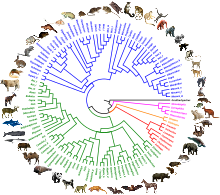Euarchontoglires
| Euarchontoglires Temporal range:
| |
|---|---|

| |
| From top to bottom (left): . | |
| Scientific classification | |
| Domain: | Eukaryota |
| Kingdom: | Animalia |
| Phylum: | Chordata |
| Class: | Mammalia |
| Magnorder: | Boreoeutheria |
| Superorder: | Euarchontoglires Murphy et al., 2001[1] |
| Subgroups | |
| |
Euarchontoglires (from:
Evolutionary affinities within mammals

The Euarchontoglires clade is based on DNA sequence analyses and retrotransposon markers that combine the clades Glires (Rodentia + Lagomorpha) and Euarchonta (Scandentia + Primates + Dermoptera).[1] It is usually discussed without a taxonomic rank but has been called a cohort, magnorder, or superorder. Relations among the four cohorts (Euarchontoglires, Xenarthra, Laurasiatheria, Afrotheria) and the identity of the placental root remain controversial.[4][5]
So far, few, if any, distinctive anatomical features have been recognized that support Euarchontoglires; nor does any strong evidence from anatomy support alternative hypotheses.[citation needed] Although both Euarchontoglires and diprotodont marsupials are documented to possess a vermiform appendix, this feature evolved as a result of convergent evolution.[6]
Euarchontoglires probably split from the
Phylogenetic relationships within the clade
The hypothesized relationship among the Euarchontoglires is as follows:[8]
| Boreoeutheria |
| ||||||||||||||||||||||||||||||
One study based on DNA analysis suggests that Scandentia and Primates are sister clades, but does not discuss the position of Dermoptera.[9] Although it is known that Scandentia is one of the most basal Euarchontoglires clades, the exact phylogenetic position is not yet considered resolved, and it may be a sister of Glires, Primatomorpha or Dermoptera or to all other Euarchontoglires.[10][5][11] Some old studies place Scandentia as sister of the Glires, invalidating Euarchonta.[12][13]
References
Further reading
- Churakov, G.; Kriegs, J. O.; Baertsch, R.; Zemann, A.; Brosius, J. R.; Schmitz, J. R. (2009). "Mosaic retroposon insertion patterns in placental mammals". PMID 19261842.
- Goloboff, Pablo A.; Catalano, Santiago A.; Mirande, J. Marcos; Szumik, Claudia A.; Arias, J. Salvador; Källersjö, Mari; Farris, James S. (2009). "Phylogenetic analysis of 73 060 taxa corroborates major eukaryotic groups". hdl:11336/78055.
- Nikolaev, Sergey; Montoya-Burgos, Juan I.; Margulies, Elliott H.; NISC Comparative Sequencing Program; Rougemont, Jacques; Nyffeler, Bruno; Antonarakis, Stylianos E. (2007). "Early History of Mammals is Elucidated with the ENCODE Multiple Species Sequencing Data". PMID 17206863.
- Springer, Mark S.; Murphy, William J.; Eizirik, Eduardo; O'Brien, Stephen J. (2003). "Placental mammal diversification and the Cretaceous–Tertiary boundary". PMID 12552136.
- Waddell, Peter J.; Kishino, Hirohisa; Ota, Rissa (2001). "A phylogenetic foundation for comparative mammalian genomics". PMID 11791233. Archived from the originalon 2019-07-10. Retrieved 2015-08-27.
- Wildman, Derek E.; Chen, Caoyi; Erez, Offer; Grossman, Lawrence I.; Goodman, Morris; Romero, Roberto (2006). "Evolution of the mammalian placenta revealed by phylogenetic analysis". Proceedings of the National Academy of Sciences. 103 (9): 3203–3208. PMID 16492730.
